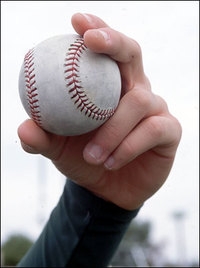Curveballs Are Actually an Optical Illusion
 The common perception of a curveball is that it flies straight after it’s thrown, then breaks and curves at some point midway through the air. In actuality, the curveball is curving the whole time, but human perception cannot detect it. Read on after the jump to see a really neat optical illusion and be inundated with science.
The common perception of a curveball is that it flies straight after it’s thrown, then breaks and curves at some point midway through the air. In actuality, the curveball is curving the whole time, but human perception cannot detect it. Read on after the jump to see a really neat optical illusion and be inundated with science.
Discovery News examines a study published over at PLoS ONE:
Batters will use their foveal, or central, vision when the ball leaves the pitcher’s hand. About 20 feet in, the batter will switch to peripheral vision, which occurs outside of the very center of the gaze. By the time the ball crosses home plate, the batter reverts back to central vision. Humans constantly switch focus like this.
The problem is peripheral vision processes first and second order motion in conjunction, while foveal vision distinguishes between the two. During the peripheral stage, batters do not notice that the curveball has been gradually changing direction ever since it left the pitcher’s mound.
Once they switch back to the foveal vision, batters accurately register the changed direction, but consider it a result of the ball’s immediate “break,” instead of their temporary impaired vision.
So, basically, our eyes just aren’t up to the task of following the curve. “Whatever, my eyes are perfect!” you might be saying, smugly leaning back in your chair. Well, click on the image below to check out a neat optical illusion that’ll prove your eyes aren’t up to the task either.
Take that, your eyes.
(PLoS ONE via Discovery News via reddit)
Have a tip we should know? [email protected]
